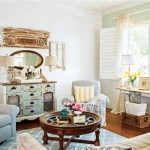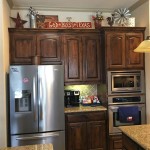Split Level House Decorating Ideas: Maximizing Style and Function
Split-level homes, characterized by their staggered floor plans and short sets of stairs, present unique decorating challenges and opportunities. Their design, popular from the mid-20th century, often results in distinct zones that require careful consideration to create a cohesive and stylish living space. Successfully decorating a split-level home involves understanding its architectural nuances and utilizing design strategies that enhance its flow, highlight its strengths, and address its inherent limitations. This article will explore various decorating ideas that can transform a split-level home into a functional and aesthetically pleasing environment.
One of the primary considerations when decorating a split-level home is the need for visual continuity. Due to the multiple levels, it is crucial to establish a consistent design theme that ties the different spaces together. This can be achieved through a unified color palette, similar flooring materials, and consistent architectural details. Without a cohesive approach, the separate levels can feel disjointed and lack a sense of harmony. Consistency doesn't necessarily mean identical décor throughout, but rather a sense of relatedness that provides a cohesive visual experience as one moves from one level to the next.
Lighting plays a critical role in defining and connecting the different levels of a split-level home. The thoughtful placement of lighting fixtures can enhance architectural features, improve functionality, and create a warm and inviting atmosphere. This includes a blend of ambient, task, and accent lighting to cater to various needs and activities within the home. Furthermore, incorporating natural light wherever possible is essential for brightening the interiors and connecting the indoor spaces with the outdoor environment. Maximizing natural light often involves strategic landscaping and careful consideration of window treatments.
Creating Visual Flow and Cohesion
The staggered layout of a split-level home can sometimes create a sense of fragmentation. It is therefore important to use design elements to establish a visual flow that connects the different levels. This can be achieved through several techniques:
Unified Color Palette: Selecting a consistent color palette is a fundamental step in achieving visual cohesion. This doesn't necessitate painting every room the same color, but rather choosing a range of complementary colors that flow seamlessly from one level to the next. Consider using a neutral base color throughout the home and introducing accent colors that vary slightly in different rooms to add visual interest while maintaining a sense of unity. For instance, shades of gray or beige can serve as a neutral backdrop, with pops of blue or green in different rooms to create a harmonious yet distinctive feel.
Consistent Flooring: Maintaining similar flooring materials throughout the main living spaces can significantly enhance the visual flow. Hardwood floors, for example, can be extended from the entryway through the living room and into the dining area to create a sense of continuity. If different flooring materials are desired in certain areas, such as tile in the kitchen or carpeting in the bedrooms, ensure that they complement the overall color palette and design style of the home. Careful selection of rugs can also help to tie different areas together, offering a cohesive feel even with varied flooring types.
Architectural Details: Repeating architectural details can create a sense of continuity and visual interest. This can include consistent trim work, molding, and door styles throughout the home. Even small details, such as the style of doorknobs or light fixtures, can contribute to the overall cohesiveness of the design. If the home lacks existing architectural details, consider adding them to enhance its character and create a more unified aesthetic. For example, adding crown molding to the living room and dining area can create a more polished and sophisticated look, while also tying these spaces together visually.
Strategically Placed Artwork and Decor: Carefully selected artwork and decor can be used to create visual connections between different levels. Consider placing a large piece of artwork on a wall that is visible from multiple levels to draw the eye upward and create a sense of connection. Similarly, using similar decorative elements, such as vases, lamps, or throw pillows, in different rooms can help to reinforce the overall design theme and create a sense of harmony. The key is to select pieces that complement each other and contribute to the overall aesthetic of the home.
Open Staircases and Railings: Replacing solid staircases and railings with more open designs can significantly improve the visual flow and allow more natural light to penetrate the lower levels. Open staircases can create a sense of airiness and spaciousness, while also allowing for better views between different levels. Consider using glass or metal railings to maximize the flow of light and create a more modern and contemporary look. The design of the staircase should complement the overall style of the home and contribute to its visual appeal. For example, a sleek and minimalist staircase with glass railings can enhance a modern split-level home, while a more traditional staircase with wooden railings can complement a more classic design.
Optimizing Lighting and Natural Light
Effective lighting is crucial for creating a welcoming and functional living space in a split-level home. Due to the often-unique layout, maximizing natural light and supplementing it with carefully chosen artificial lighting is essential.
Maximizing Natural Light: The strategic placement of windows and skylights can significantly increase the amount of natural light that enters the home. Consider adding larger windows or skylights to rooms that tend to be dark or poorly lit. Light-colored window treatments, such as sheer curtains or blinds, can also help to maximize the amount of natural light that enters the room. Avoid heavy drapes or curtains that can block out natural light. Proper landscaping can also contribute to maximizing natural light by trimming trees and shrubs that may be blocking sunlight from entering the home. The goal is to create a bright and airy interior that feels connected to the outdoor environment.
Layered Lighting Approach: A layered lighting approach involves combining ambient, task, and accent lighting to create a balanced and functional lighting scheme. Ambient lighting provides overall illumination for the room, while task lighting is focused on specific areas where tasks are performed, such as reading or cooking. Accent lighting is used to highlight architectural features, artwork, or other decorative elements. By combining these different types of lighting, it is possible to create a lighting scheme that is both functional and aesthetically pleasing. For example, recessed lighting can provide ambient illumination, while pendant lights can provide task lighting over a kitchen island. Accent lighting can be used to highlight a piece of artwork or a fireplace.
Smart Lighting Solutions: Implementing smart lighting solutions can enhance the functionality and energy efficiency of the home. Smart lighting systems allow for remote control and automation of lighting fixtures, making it easy to adjust the lighting levels based on the time of day or the activity being performed. Smart bulbs can also be programmed to change color temperature, allowing for warmer lighting in the evening and cooler lighting during the day. Motion-sensing lights can be used in hallways and staircases to provide automatic illumination when needed, while also saving energy. Smart lighting systems can be integrated with other smart home devices, such as voice assistants and smart thermostats, to create a fully automated and connected home.
Consider Uplighting: Uplighting, where light is directed upwards, can visually expand a space and highlight architectural details. This technique works well in split-level homes due to the changes in ceiling height. Placing uplights behind furniture or architectural features can create a sense of depth and drama, while also adding a warm and inviting glow to the room. Uplighting can be particularly effective in hallways and staircases, where it can help to illuminate the space and create a more welcoming atmosphere. Consider using LED uplights, as they are energy-efficient and produce very little heat.
Light Fixture Style Consistency: While each level might have distinct lighting requirements, maintaining a consistent style of light fixtures throughout the home can contribute to visual harmony. This doesn't mean using identical fixtures but ensuring that the style, finish, and materials complement each other. For example, if the living room features modern pendant lights with a brushed nickel finish, consider using similar finishes and styles in the dining room and kitchen. This consistency will help to tie the different spaces together and create a more cohesive look.
Addressing Common Split-Level Challenges
Split-level homes often present unique challenges due to their layout, including awkward spaces, limited natural light, and a sense of disconnection between the different levels. Addressing these challenges effectively is essential for creating a comfortable and functional living space.
Optimizing Awkward Spaces: Split-level homes often have awkward spaces or oddly shaped rooms that can be difficult to furnish and decorate. These spaces can be turned into functional and stylish areas by thinking creatively and using space-saving solutions. Consider using custom-built furniture to maximize the use of available space. For example, a built-in bookcase or storage unit can be designed to fit perfectly into an alcove or under a staircase. Multifunctional furniture, such as a sofa bed or a coffee table with storage, can also be used to make the most of limited space. In addition, consider using mirrors to create the illusion of more space. Placing a large mirror on a wall can reflect light and make the room feel larger and more open.
Enhancing Privacy: The open layout of some split-level homes can sometimes compromise privacy, particularly in the living room or dining area. Consider using room dividers, screens, or curtains to create more private spaces. A room divider can be used to separate the living room from the dining area, while curtains can be used to create a more intimate and cozy feel in the bedroom. In addition, consider using soundproofing materials to reduce noise transmission between different levels. This can be particularly important in homes with young children or teenagers. Soundproofing can be achieved by adding insulation to the walls and floors, or by using sound-absorbing materials, such as rugs and curtains.
Creating a Focal Point: Establishing a focal point in each room can help to draw the eye and create a sense of visual interest. This can be achieved by highlighting an architectural feature, such as a fireplace or a large window, or by creating a display of artwork or decorative objects. The focal point should be the first thing that catches the eye when entering the room and should be used to anchor the design of the space. For example, in the living room, a fireplace can serve as a focal point, while in the bedroom, the bed can be the focal point. The key is to select a focal point that is appropriate for the room and that complements the overall design style of the home.
Vertical Emphasis: Since split-level homes are often horizontally oriented, emphasizing vertical elements can add a sense of height and balance. This can be achieved through tall bookshelves, floor-to-ceiling curtains, or vertical artwork. By drawing the eye upwards, these elements can make the rooms feel taller and more spacious. The vertical emphasis should complement the horizontal lines of the home and create a sense of visual harmony.
Staircase Transformation: As a prominent feature, the staircase offers an opportunity to transform the aesthetic of the home. Upgrading the railing, adding a runner, or incorporating decorative lighting can dramatically change the look and feel of the staircase. The staircase can also be painted or stained to match the overall color scheme of the home. Consider using a bold color or pattern to make the staircase a focal point. In addition, consider adding artwork or decorative objects to the walls along the staircase to create a more visually interesting space.
By carefully considering these decorating ideas, homeowners can transform their split-level homes into stylish and functional living spaces. The key is to embrace the unique architectural characteristics of the home and to use design strategies that enhance its strengths and address its limitations.

30 Awesome Living Room Split Page Level Decor Ideas Renewal Remodel Livingroom Layout Remodeling

Cozy Loft Set Up 2 Split Foyer Remodel Home Remodeling

Home Tour A Cramped Split Level Transforms With Spacious Mid Century Style

How To Modernize A Split Level Home Match Your Style Neighbourly Expert Tips

30 Awesome Living Room Split Page Level Decor Ideas Renewal Remodel Home Remodeling

These Split Level Homes Get The Style Right

A Diy Split Level Entry Makeover Before After Lemon Thistle

Johanna S Split Entry Renovation Design Group

30 Awesome Living Room Split Page Level Decor Ideas Renewal Furniture Layout Arrangement Remodel

Gallery Of Split Level House Qb Design 7
Related Posts







